Raise your hand if you’ve ever read an amazing marketing guide, tried to implement it, and failed to replicate the same level of success outlined in the article.
C'mon, raise em! We’ve all done it.
Maybe it’s because the guide you read was overhyped or outdated.
But then, you hear about a few marketers who implemented the same guide and got successful results.
What are those marketers doing differently that you’re not? Are they smarter than you? Is there some secret tool everyone is keeping to themselves?
No.
Here’s the difference: You’re just blindly implementing marketing tactics you’ve read about and seeing which ones “stick”.

- You blindly change your button to red because some article told you so.
- You blindly try marketing with Snapchat because it’s the latest craze.
- You blindly start guest posting because every marketing blog says so.
You’re blindly implementing marketing tactics and hoping it’ll work.
And that needs to stop. Stop relying on luck and praying something will work.
Instead, you need to have a marketing framework so you can predict which marketing tactics will work for your specific business and circumstances.
I’m not saying not to read marketing guides anymore. In fact, you should – it’s a great way to stay up-to-date on the latest marketing techniques. But the point is this:
You need to have a systematic and scientific approach for your own online marketing strategy.
The exact same approach:
- Noah (Chief Sumo) used to acquire 100,000 users in 6 months.
- Sarah (Marketing Sumo) used to get 50,000 Instagram followers in 90 days.
- We used to increase our monthly traffic by 345,000 in 90 days.

That’s because if you do this right, you’ll be able to:
- Prioritize marketing strategies: There are thousands of online marketing strategies for you to try. You need a way to focus only on the best ones for your business.
- Run 80/20 experiments: Just like in your high school science class, you need to run experiments to verify your hypothesis/assumptions. You need an efficient way to run quick tests before you spend too much time or money on a specific marketing tactic.
- Know what to tweak: Every business is different, no matter how good of a guide you just read, you can’t simply copy/paste the strategy over to your business. You’ll have to make unique tweaks/improvements specifically for your business.
- Scale your marketing: Once you find an effective marketing channel after doing the tests & tweaks, you need a way to scale the marketing tactic to get into the big leagues.
So let’s take a look at some real life examples of why it’s important to have a scientific process for marketing.

Why Every Marketer Needs To Also Be A Scientist
I’ll bet you an unlimited supply of tacos that every successful marketer is also a scientist.

No, not that type of scientist…
This type!

They might not have a science degree (you don’t need one), but they all understand the importance of applying the scientific method to marketing.
So what is the scientific method?
It’s a way to solve a question or problem by making observations and doing experiments. The whole concept is to be able to predict and repeat your experiments.
By applying the same approach to marketing, you can predict which marketing tactics will be the most effective by running small tests to gather data.
With that information, you can make tweaks to scale and improve your marketing experiments.
Here’s a summary of how it works:

So why is this so important?
Let’s look at an example, Dropbox.
In September of 2008, Dropbox had 100,000 users. Just 15 months later, they had 4 MILLION users.
After looking at their growth curve, you may be wondering:
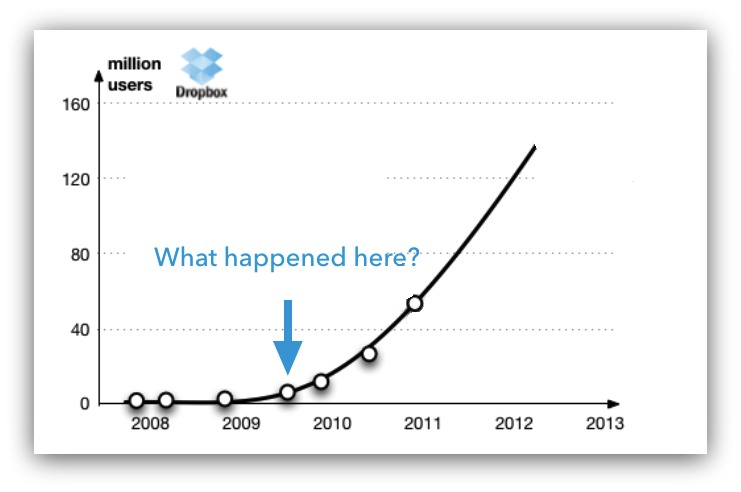
What did Dropbox do before the exponential growth? Is there a guide out there so others can replicate their success?
Those would be the wrong questions to ask. Instead, what you should be asking is:
What did Dropbox do BEFORE, DURING, and AFTER the exponential growth?
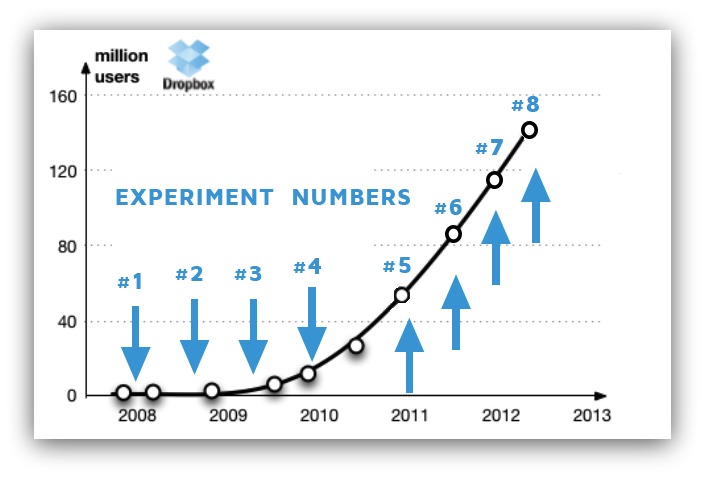
Dropbox achieved their growth by running tons of marketing experiments to gather enough data so they knew exactly which marketing tactics to implement.
Smaller experiments like this:
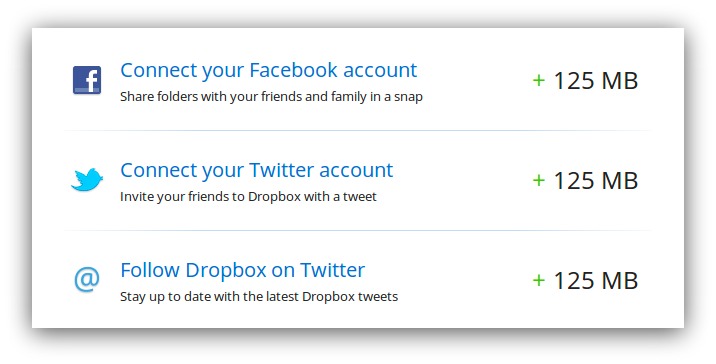
Based on those smaller experiments, Dropbox eventually learned that many users were willing to complete high “friction point” actions (e.g. it’s hard to convince people to connect their social media accounts) in return for free storage space.
From there, it took even more testing and tweaks for Dropbox to know exactly how to execute their online marketing strategy.
Only then did Dropbox come up with the infamous referral program that resulted in 35% of their new users:

Referral programs are nothing new, and there are plenty of existing guides on it. However, if the marketers at Dropbox tried to copy/paste a guide to their own business, they would have failed.
The same applies to you. This guide you’re reading isn’t an article on “How to Create a Viral Referral Program like Dropbox”.
That’s because you wouldn’t be able to replicate Dropbox’s success because your business is different.
What you should be focusing on instead is not the marketing tactics Dropbox used (i.e. referral program). Instead, you should focus on the systematic and scientific framework that Dropbox followed to generate, test, and scale their marketing ideas.
That’s why one of the mantras we live by at Sumo is:
For every single online marketing strategy we approach at Sumo (e.g. facebook groups, content marketing, SEO, instagram, etc…), we use the same scientific framework.
And that’s exactly what we’ll go over in this guide:
How you can build your own systematic marketing framework using quant-based marketing.

The best thing?
You don’t need to be a genius, have an engineering or science background. I’ll be providing tons of real-life case studies, examples, and also all the tools/spreadsheets you’ll need to do the same thing.
So grab a taco and settle in.
Step 1: Working Backwards to Create Your Goal
Just like in a science experiment, you need to have an objective. Why are you doing the experiment in the first place? What are you trying to achieve?
This step seems so obvious, but it’s still something I see many beginner marketers and entrepreneurs not do.
You need to have a goal.
Doing too many things at once is always a recipe for failure. Have a singular focus towards just one goal so you know exactly which direction your business needs to go.
But how do you create smart goals? How do you create goals that are big enough to impact your business, but are also realistic enough for you to achieve?
To show you how to create an amazing goal, let’s use a simple example.
For the sake of simplicity, let’s assume:
- You make $52,000/year (that’s $1000/week),
- You don’t pay taxes (all cash money!!!),
- You have no expenses because you live with your parents.
- You want to become a millionaire
A TERRIBLE goal would look like this, “I want to become a millionaire.”
So why is this a terrible goal?
To answer this, let’s see what an amazing goal would look like:
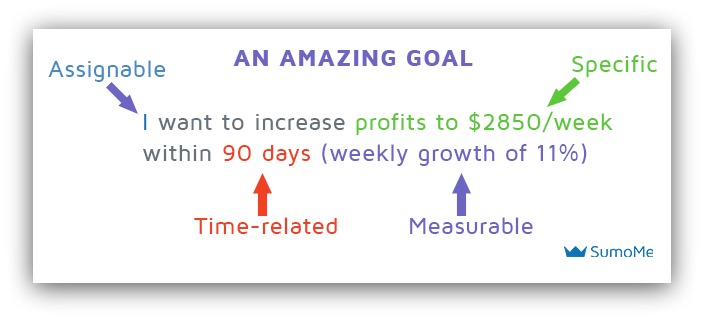
An amazing goal is a SMART one, it’s:
- Specific: To make it specific, break down your end goal. To become a millionaire in 5 years, you would need to make $200,000/year or $3850/week. Since you’re already making $1000/week, you would need to increase profits by $2850/week.
- Measurable: Make it so you can measure the progress of your goal each week. If you’re off-track, you’ll know right away and can make changes to get back on track. So to increase profits by $2850 in 90 days, you would need 11% growth each week.
- Assignable: Who is the one person who will be responsible for the success or failure of the goal?
- Realistic: What are the inputs you can leverage to meet your required goal? How are you going to increase profits by $2850/week? It’s up to you to brainstorm ways to do this. Once you have an idea of how to achieve the goal, compare it with your available resources, capabilities, and industry benchmarks to know if it’s achievable/realistic.
- Time-related: How much time are you going to give yourself? Typically, good goals have a timeframe between 30-90 days. Anything less than 30 days, and you’re not aiming high enough. Anything more than 90 days, you may be biting off more than you can chew.
The whole concept behind quant-based marketing is to work backwards to your solution. Starting with your end vision (e.g. I want to become a millionaire), you make iterative steps backward to break it down into more manageable goals.
Now since this isn’t a personal finance blog, let’s go into greater detail on how to set goals in the marketing world.
For marketing, your goal is going to fall under the metrics part of the AARRR funnel.
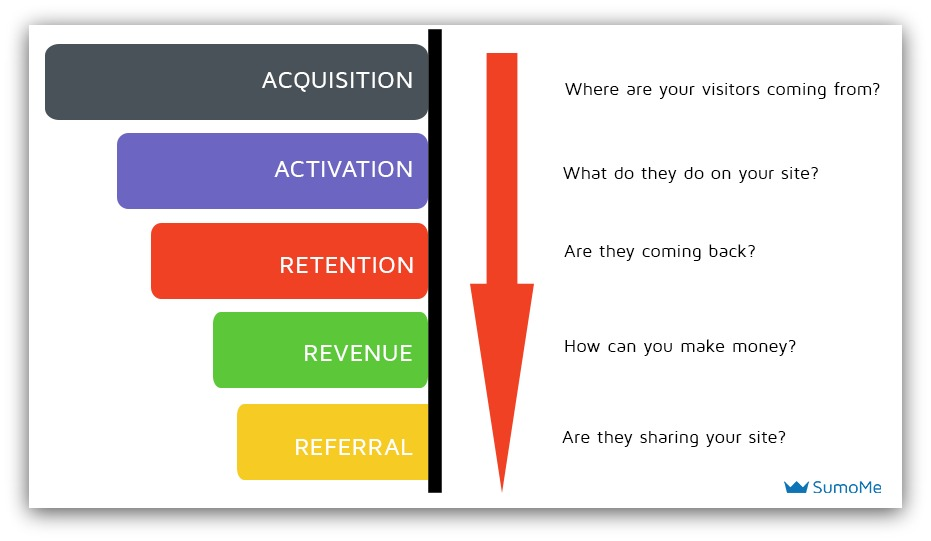
It’s up to you to know which category of the AARRR funnel will have the biggest impact to your business.
Maybe you’re the owner and want to focus on increasing revenues by $500K/year so you can raise money at a $5MM company valuation.
Maybe your boss told you to focus on acquisition by increasing traffic to 400 unique visitors/day.
Maybe you want a job at your dream company and want to build your blog to 1000 email subscribers for your portfolio.
There are many ways you can define your goal. To get your brain juices flowing, here are some examples of goals you can use:
Acquisition
- Increase direct/search/referral unique visitors: Improve either the number of people typing in your url into the browser, coming from google, or coming from another site.
- Interactions per visit: Even if your visitors don’t convert, by increasing the amount of time they spend on your site, you could leverage the increased time into increased conversions.
- Increase click-through-rate: Improving the effectiveness of your ads at inspiring an impression to act and visit your site.
Activation
- Increase number of trials started: If you notice that you have a high conversion rate from trial to paid users, you may want to focus on encouraging visitors to sign up for trial accounts.
- Increase email subscribers: Turn your blog visitors into subscribers by asking them to give you their email using Welcome Mat or List Builder
- Optimizing your bounce rate: If you’re driving in a lot of traffic but they’re all leaving without doing anything, focus on decreasing your bounce rate (e.g. reduce page load time)
Retention/Churn
- Increasing the number of returning visitors: Encouraging users to check into your website (blog/ecommerce store) frequently.
- Increasing your monthly active users: Increasing the number of people who frequently use your product. The more they use your product, the less likely they’ll leave
Revenue
- Reduce cart abandonment rate: The percentage of people who started the checkout process but did not complete it
- Increase average order size: Improving the number of products people buy on your product or encouraging visitors to select the more expensive pricing plans
- Increasing your customer lifetime value: Increase the revenue associated per customer over the course of their relationship with your business
Referral
- Increasing your net promoter score: Increasing the likelihood of your customers to refer your business
- Increasing your viral coefficient: How many the number of invites your customers sends to their friends, and the conversion rate of those referrals
- Increase number of social media shares: The number of times your content is shared on Facebook/Twitter/Linkedin/Pinterest/Instagram etc…
I can’t tell you which goal to choose, that’s something you’ll have to figure out on your own. However, here’s an example to put things into perspective.
Example: Noah Kagan’s Goal of 100,000 Users in 6 Months
When Noah Kagan joined Mint.com as the #4 employee, the founder (Aaron Patzer) told him to create an online marketing strategy to acquire 100,000 registered users in 6 months after launching.
How did Aaron come up with that goal? I can’t speak for Aaron, but here’s a quote from Noah on how he decides on goals for Sumo:
“In most cases, the company’s goal is worked backwards from the amount of revenue you are targeting. So if you want a valuation or specific revenue, you can figure how many signups and customers are required to hit that number”.
So one example could be:
I want to raise $X dollars at a company valuation of $Y within 6 months from launching.
With that starting point, Aaron could have worked backwards and figured out he would need about 100,000 registered users in 6 months after launching. Here are a couple simplified points that could be used to help define the goal:
- Industry Benchmark Valuations: looking at how many users similar companies in the same industry had when raising funds
- Average Revenue per User (ARPU): Based on a few assumptions, he could calculate the ARPU multiplied by total users to get a revenue projection. Based on that, he could apply a multiple on it to get a ballpark figure of a valuation
And guess what?
6 months after launching, Mint.com raised a seed round of ~$1MM.

But if you were in Noah’s situation, how would you know if a goal of 100,000 users in 6 months is realistic?
If the goals were unrealistic, he’d be setting himself up for failure.
That’s why you need to break down your goal by working backwards.
And the best way to break it down is to focus on the inputs.
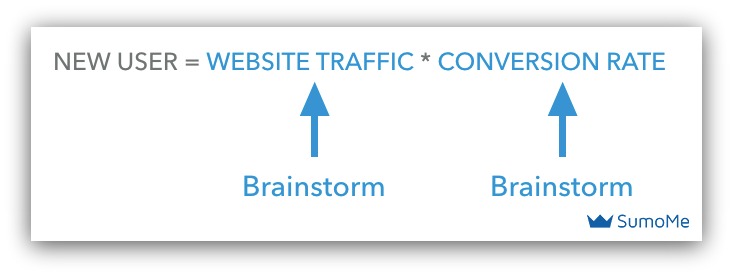
So if Noah had to get 100,000 users in 6 months, he would work backwards to estimate how much website traffic he would need, and at what conversion rates.
Just like in a science experiment, before you begin testing, you need to do some research and brainstorm ideas on how to approach the objective.
This is where you leverage the knowledge from relevant guides, your personal experience, and also the experience of others (mentors/colleagues/peers).
For example, after doing some brainstorming, Noah was able to come up with the top 10 sources of traffic that would contribute to the goal of acquiring 100,000 users in 6 months.
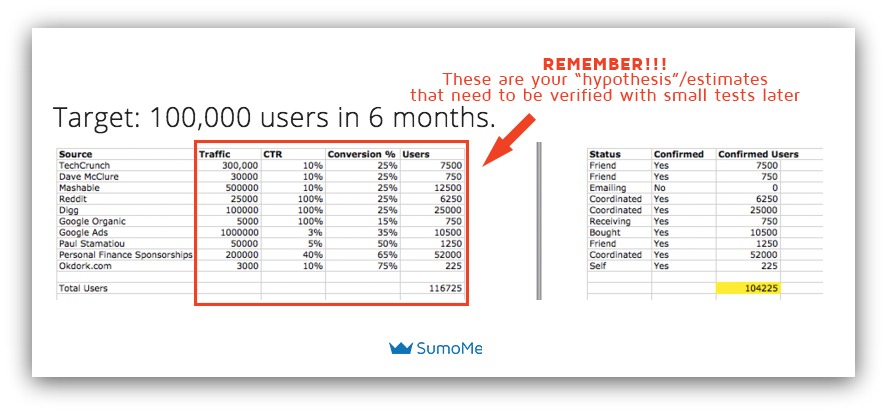
(Download this spreadsheet by CLICKING HERE! This is the only section to do it.)
How did Noah know the values for the traffic, click-through-rate, and conversion rate?
He didn’t, but just like in science, you make a hypothesis. A hypothesis is an educated guess based on the best available information you have at the time.
For example, to find out how much traffic TechCrunch has, you could use a tool like SEMRush.com to get a ball park number:

Alternatively, many of the major websites will have their own “advertise” page that will provide you with information for your hypothesis. For example, here’s TechCrunch’s Advertise page:

To make a hypothesis on the click-through-rate or conversion rates, it’s a bit more tricky.
If you’re going to advertise on a major platform, send an email to the advertising team and generally they’ll provide you with a brochure that will include key advertising metrics you’ll need to know (e.g. click-through-rate, CPM, cost-per-click, etc…)
If you can’t get access to that information, it’ll be a mix of relying on your previous experience, doing research to find industry benchmarks, and talking to your peers in similar industries.
By using this approach to work backwards from the main goal, Noah had a pretty good idea that getting to 100,000 users in 6 months was realistic based on the resources they had available, and the team’s capabilities.
The results?
Mint signed up 1 MILLION users in 6 months. In case you suck at math, that’s 10x the goal!
Do you see the importance of defining your goal based on what will have the biggest impact to your business?
Follow the quant-based marketing framework by working backwards from your end vision, and break the vision down into manageable steps. By doing so, you’ll have a good idea of what needs to be done to reach your goal so you can gauge if it’s realistic based on your available resources.
Once you have brainstormed a bunch of ideas on how to reach your goal, the next step is to prioritize which ideas to focus on first.
Step 2: Prioritize So You Know Exactly What To Do Next
Want to know one of the best ways to impress your boss?
When you finish a task that was given to you, have the initiative to propose work without even being asked.
But it’s not enough to have initiative, you need to know exactly which actions will also have the largest impact to the business.
Every day, there’s tons of guides that come out on Facebook Marketing, Growth Hacking Reddit, Driving Traffic from Twitter, and so on. It’d be very inefficient to attempt to implement every guide you read.
That’s why you need to learn how to prioritize your marketing strategies.
The way you prioritize what needs to be done is always based on what your goals are. Here’s an example:
Example Goal: 100 New Email Subscribers In One Week
Let’s say you have a goal to get 100 new email subscribers in one week.
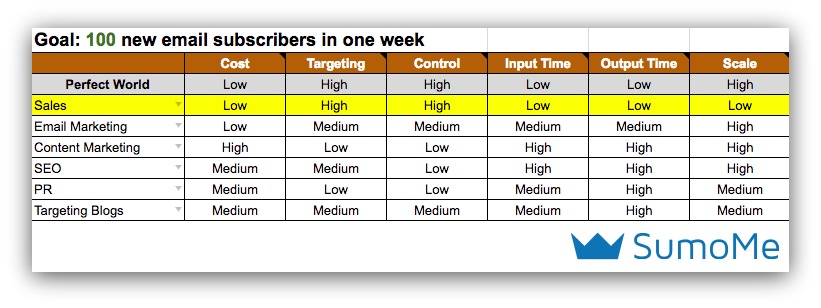
Would it make sense to do a full fledge PR campaign or SEO marketing strategy?
No it wouldn’t!
To get 100 email subscribers in one week, you only need 14 subscribers per day. And since you only have a week, it doesn’t make sense to do PR/SEO because it requires a lot of work (input time), and also time to see the results (output time).
However, maybe direct sales such as sending private PMs to redditors, or texting your friends would be more reasonable.
For my own personal blog, when I first started I had a goal of 100 email subscribers in one week.
To prioritize how I would reach my goal, I would compare each marketing tactic by the probability of success, impact, and resources required to implement.
Here’s how I did it:

(Download this spreadsheet by Clicking Here!!)
Every time I read an amazing marketing guide, I would write it down in my ideas backlog spreadsheet. If you’re just starting out, and need some inspiration for your backlog, check out the 130 Ways to Get Traffic.
Now when it’s time to pick a marketing channel to work on, I prioritized cold calling my personal network based on:
- Probability of success (HIGH) – Worst case scenario, since I have ~600 connections on Facebook, I would need a minimum conversion rate of 16% to succeed. I assumed a conversion rate of 30% since they were my friends and were more likely to sign up.
- Impact (MEDIUM) – In addition to the direct signups in my own personal network, I will also leverage word-of-mouth to get friends-of-friends to sign up.
- Resources Required (LOW) – It takes very little time to copy and paste a message template (with a bit of personal customization).
Since I assumed a conversion rate of 30%, I would only need to reach out to 333 of my friends on Facebook/text to reach my goal:

The results?
I only had to reach out to 232 of my friends because my conversion rate was actually 64%, which resulted in 142 email subscribers in one week.
In this case, an online marketing strategy like guest posting would have been overkill, and would have been too time consuming to meet my goal.
Something much simpler like direct sales was more appropriate to reach the goal of 100 email subscribers in one week.
Example Goal: Increase Traffic By 400 Unique Visitors/Day in 90 Days
Last week, Sarah Peterson (Marketing Sumo) asked me to increase our website’s traffic by 400 unique visitors per day from one channel, and she gave me 90 days to do it.
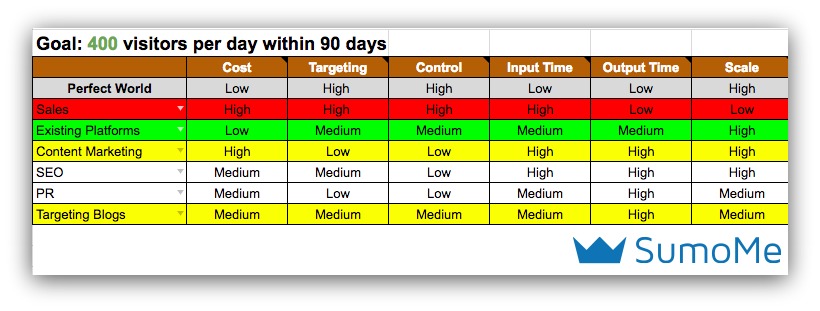
A direct sales approach like in the previous example would not be realistic or feasible.
Why?
Let’s think it through using the quant-based marketing framework and work backwards to determine if this is realistic.
To get 400 unique visitors per day, how many people would I need to personally reach out to?
Assuming the same conversion rate of 64%, I would need to reach out to 645 people EVERY day. Plus, my conversion rate was high, only because they were my peers.
The only way I could personally reach out to that many people would be if I had an automated system or hired a sales team, both of which are potentially expensive and complicated solutions.
It’s simply not scalable.
However, marketing strategies like guest posting, content marketing, or targeting existing platforms (Reddit, Quora, Growthackers, etc…) may be more feasible.
To narrow it down further, let’s take a look at the “priority spreadsheet”:
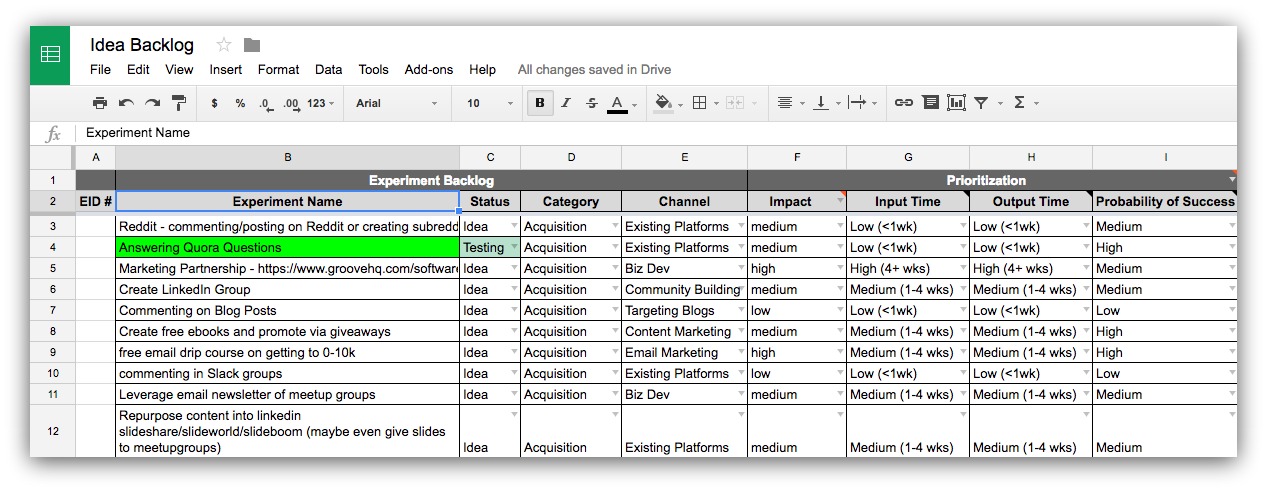
(Download this spreadsheet by Clicking Here!)
Based on all the other available tactics, I prioritized answering questions on Quora based on:
- Probability of success (HIGH) – I was confident in this channel because of my previous experience with Quora to drive traffic to my other sites. I also read a bunch of guides and they included their conversion rates, so I used those numbers in my assumptions.
- Impact (MEDIUM) – Based on research, I realized India accounts for 40% of Quora’s traffic. Looking at Sumo’s Google Analytics, one of our highest converting demographics are also from India.
- Resources Required (LOW) – Since I’ll be repurposing existing content, all I would have to do is change the wording and format a little bit instead of creating something new.
It’s important to note that all these decisions are just assumptions. And because of that, you don’t know if your assumptions are accurate.

You don’t want to right away start hiring a freelancer or creating a full-fledge marketing plan without verifying the assumptions.
You need to validate your assumptions by running small 80/20 marketing experiments.
That’s why the next step is to run quick experiments so you can learn from those tests effectively, and apply those learnings to improve on the specific marketing tactics.
Step 3: Validating Your Assumptions with 80/20 Experiments
Have you heard of what a Minimum Viable Product (MVP) is?
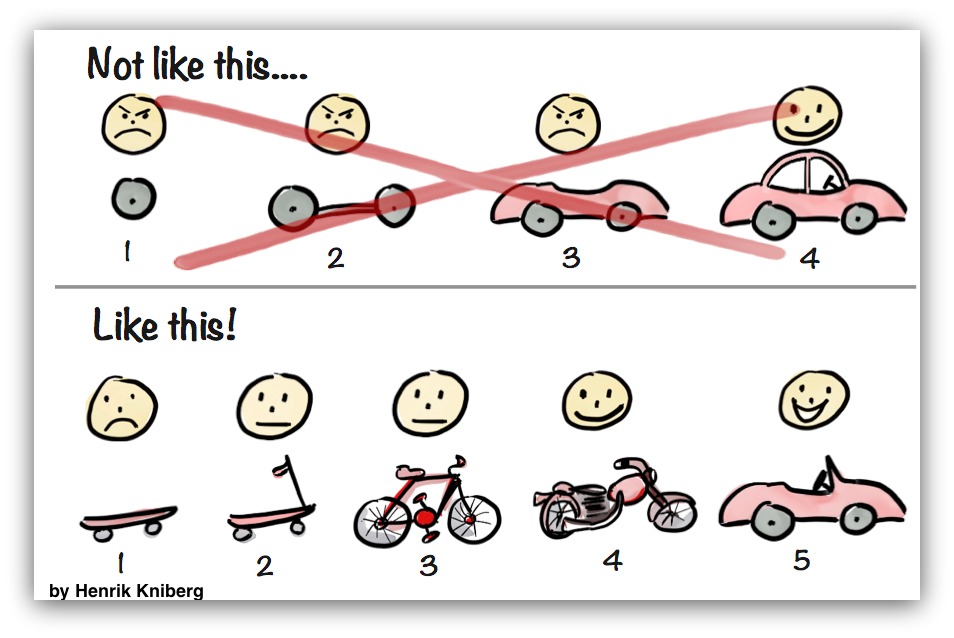
A MVP is a product that has the minimum amount of features required to validate people want it.
For example, Justin Mare’s used a simple landing page with a link to his PayPal account for his business validation.
His landing page was the minimum amount of features required to get pre-sales to validate his business. Only once he validated his business, did he start spending more time and money to do it properly.
The same applies to marketing, except it’s called a Minimum Viable Test. Before you start spending too much time implementing a marketing tactic, you need to do a quick test first.
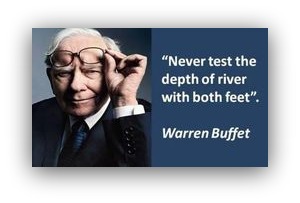
To do this, again use the quant-based marketing approach to work backwards. Here’s an example:
Example – Starting With 1-on-1 Private Messages On Reddit
Just as a quick re-cap, as mentioned in the previous step, my goal was 1000 email subscribers in 90 days.
After leveraging my own personal network, I had about ~150 email subscribers which were my friends, or friends-of-friends.
To reach my 1000 email subscriber growth, after working backwards, I determined I would need ~16% growth each week:
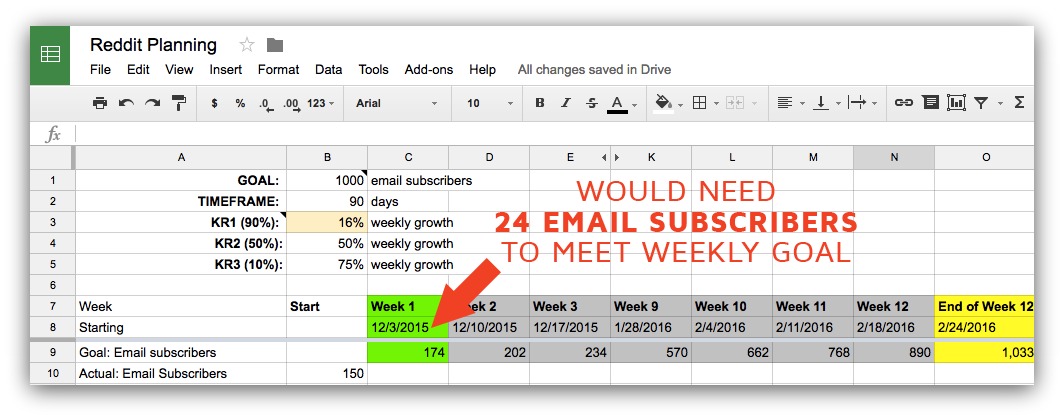
(Download this spreadsheet by Clicking Here! )
I can’t stress how important this is, so I’ll repeat it again:
WORK BACKWARDS FROM YOUR GOAL!
By working backwards from the “1000 email subscribers in 90 days” goal, I was able to define the objective to: “I need 24 email subscribers this week”.
Sounds a lot more manageable and realistic right?
I ultimately decided on experimenting with Reddit as a marketing channel because I had read about it and it seemed interesting. But first, I would need to do a minimum viable test to see if Reddit would be an effective marketing channel.
To do the test, I would send a private 1-on-1 PM to random redditors giving them a link to my website with the assumption I would have a 25% conversion rate.
Now you’re probably wondering…
How did I get that 25% conversion rate number?
It was just a guess based on my previous experiment where I sent a 1-on-1 PM to my friends. It’s just an assumption which is why I need to verify it.
Here’s the outline of my marketing experiment:

See how my objective was to validate my conversion rate?
From there, I created a marketing plan of how I was going to execute it.
Don’t skip this part and just blindly start working without a plan.
Spend at least 30 minutes to come up with a plan so you actually document what you’ll do (comes in handy when you create a playbook), and it forces you to think methodically on the strategy. Here’s what my test plan looked like:

Now that the test plan is ready, it’s time to actually execute!
I only have two pieces of advice when you actually execute your marketing plan:
- Test 2-3 different messages and see which one gets the highest response (e.g. copy, value proposition, landing page design, etc…)
- Keep track of your progress using a spreadsheet. Make notes on what works, and what didn’t so you can make tweaks later on.
The results?
I sent a total of 46 messages to redditors that looked like this:

Of which 18 people signed which equates to a conversion rate of 39%. That was higher than my assumption! I’ll go into the reasons why later, but basically it was because of using Seth Godin’s permission marketing techniques.
Here’s another example on how to run a 80/20 test.
Example – An Experiment to Test the Effectiveness of Quora
This experiment is on-going and I’ll have a full fledge guide on it in a few months. But what I want to show you is another example of how to come up with an 80/20 marketing experiment.
If you recall earlier, Sarah gave me the task of increasing traffic by 400 visitors/day within 90 days. So again, following the same steps in the first example, let’s break it down.
I want you to truly think about this question:
How can the target of “400 visitors/day within 90 days” be made more manageable?
Don’t scroll down yet, take a few seconds to think it through based on the previous example.

Alright ready?
Did you work backwards from the main goal? Did you break it down?
If so, you should have a weekly growth target and it should look something like this:
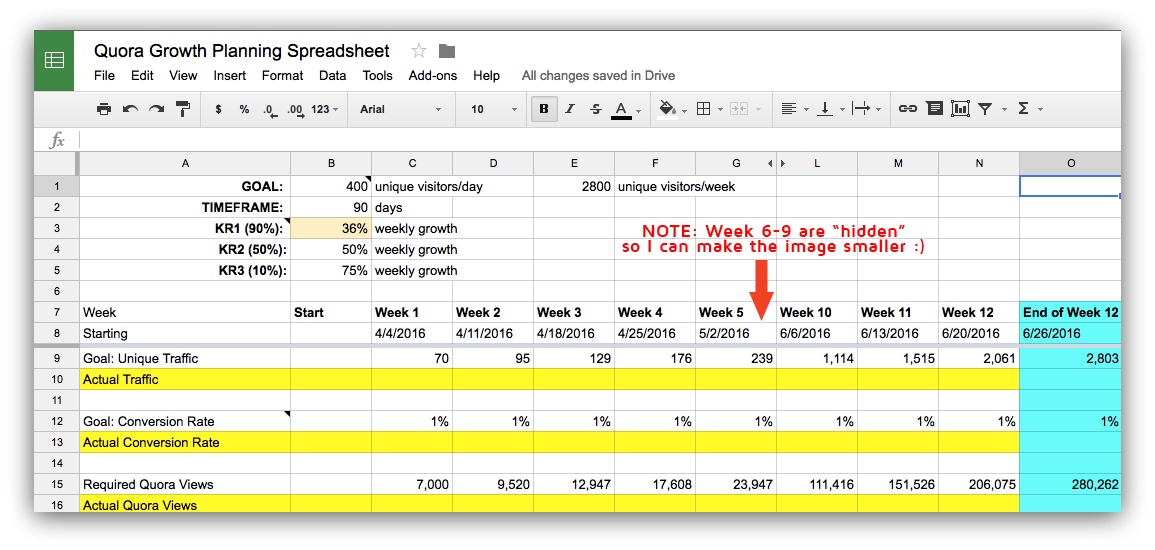
The goal of 400 visitors/day is 2800 visitors in a week.
So ask yourself…
How much weekly growth would I need to go from 0 to 2800 visitors/week within 90 days?
If I start with 70 visitors in the first week, I would need to have week-to-week growth of 36% to reach my goal. So in the second week, I would only need 25 visitors, 34 visitors for the third week, and so on.
Now that I worked backwards from the main goal, I have weekly targets that are much smaller and manageable. Having these weekly targets will help me measure my progress so I’ll know if something is working or not.
That’s why I highlighted the very important rows in yellow, the “ACTUAL” rows. These are the metrics that I will need to track in order to adjust my assumptions.
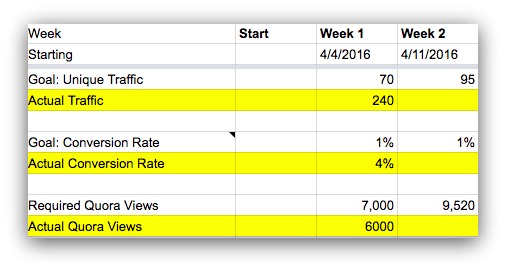
What are my assumptions?
I’m assuming a conversion rate of 1% (Quora views to website traffic). Within the first couple weeks, I should have enough data to verify if the 1% assumption is accurate or not.
If the “ACTUAL” is:
- Less than my assumption: I need to find out why! Maybe it’s because I’m not using a compelling copy, or my answer’s are too short, etc…
- More than my assumption: I also need to find out why! That’s so I can figure out how I can repeat what works, and keep doing more of that.
By following this process, you’ll know which areas of your online marketing strategy are working, and which areas are failing.
That’s how you identify the weak points so you can improve and optimize it. You can also narrow specifically on what’s working, so you can scale it later on.
Once you have your weekly targets set up, same with the previous example, you need to create an experimental plan and document what you did:

(Download this spreadsheet by Clicking Here! )
Once the plan is done, it’s time to execute it!
Now the most important step comes after you’ve ran your experiment for a couple weeks. You need to take a step back and analyze the results and identify the learnings to know what works, and what doesn’t.
Step 4: Asking The Most Important Question
After you’re done running your experiment or have a few weeks of data, you need to ask the most important question of them all:
Why did your experiment succeed or fail?
You need to understand why your assumptions were accurate or inaccurate. If the conversion rate is much lower than your assumption, ask why?
- Maybe your copy could be improved?
- Maybe you could write a more effective headline?
- Maybe you could test a different value proposition?
This is why the key to the quant-based marketing framework is to measure your results in a spreadsheet. If you’re just doing things willy-nilly, you’ll have no idea what’s working and what’s not.
Let’s go back to my previous Reddit Example…
After my experiment to send 1-on-1 messages to random redditors, I wanted to understand, “Why was my conversion rate higher than expected?”
By having the answer to that question, it will allow me to improve on the online marketing strategy and scale it even further.
To do this, I sent follow-up messages to everyone who signed up and would ask them:
“Why did you trust me with your email when I just sent you a random PM?”
And I would get responses like this:

And

By asking why, my main learnings from this experiment were:
- Importance of permission marketing techniques (instead of sending a link in the first PM, I asked for permission)
- Customizing a few sections of the message to make it personal was very effective /r/entrepreneur had my target demographic
Now once you understand why your experiment is a success or failure, it will tell you what to do next.
That’s because you need to improve your online marketing strategy in an iterative process.
You don’t want to spend a bunch of time and money on an online marketing strategy that’s not proven.
So instead of sending private 1-on-1 messages, I would do the exact same thing but I would comment on posts so more people can see my message. I can then apply learnings to make this marketing channel even more effective.
For example, here’s a post where I didn’t implement the permission marketing techniques:

I got downvoted to -7 points immediately!
But if I applied the learnings from the previous experiment in regards to permission marketing techniques from the previous experiment, I would get results like this:

Basically in my original comment, I would just say, “reply to this comment if you want the link” and people would ask me for it!
Once they asked me for it, I would publicly comment on it so other people will see it, and once I get enough upvotes/comments, I’d update my original comment to look like this:
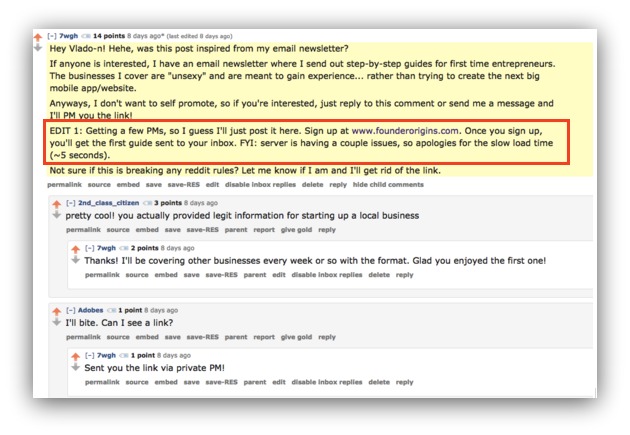
The results?
By just commenting on Reddit posts, I got ~1000 email subscribers in one month.
But if I didn’t run 80/20 experiments and start small…
- I wouldn’t have known how to implement this strategy effectively.
- I wouldn’t have known the importance of permission marketing techniques.
- I wouldn’t have known which messages would be the most effective.
And now that I proved commenting on posts is successful, what do you think would be the next iterative progression?
Creating posts! Now more people would be exposed to my message!
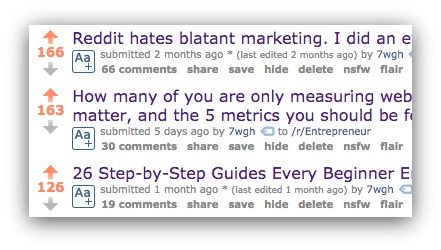
Just to re-iterate the effectiveness of starting with small 80/20 marketing experiments:
If you understand “why” your experiment was a success or failure, you’ll know exactly what to do next.
By running experiments, I started with messaging my friends, and all the way to a full fledge online marketing strategy for community-based platforms:

By running these small tests, you can look for opportunities to apply your learnings to other similar marketing strategies.
For example, I applied the same learnings to Reddit on other subreddits, and also other platforms like Inbound/GrowthHackers/Quora etc…
So follow the quant-based marketing framework by working backwards from your main goal, break it down into smaller weekly growth targets, and start small to meet those weekly targets.
Begin to implement your lessons learned from those smaller weekly targets, make tweaks, and start scaling your online marketing strategy.
Only once you’ve verified your assumptions with a minimum viable test, you can begin to scale by spending more resources and money into a channel.
Step 5: Scale What Works So You Can 10x Your Results
You should only be at this step if you’ve found a marketing channel that shows promise.
If you understand why a marketing channel isn’t working and it’s not reasonable to fix it, move onto the next marketing channel on your priority list.
However, if you’ve found an effective marketing channel, it’s time to put in more of your resources into that channel so you can 10x your results.
There are two ways to scale a marketing channel.
You can either leverage technology or create a playbook.
Again, using my Reddit example, how could I scale it?
Using Technology
Based on additional learnings from commenting on posts, I realized the importance of being one of the first people to comment on a new post.
I would put certain keywords down so I would get notified every time someone created a new post that was relevant to my website.
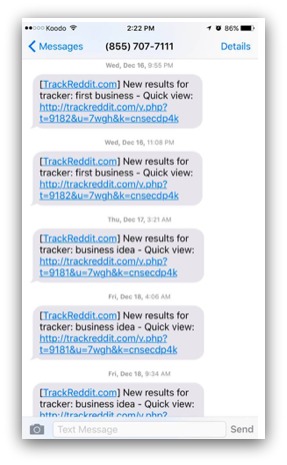
Using that piece of technology, I’d be one of the first users to comment on every single post relevant to my business. That’s how I maximized the number of people who would see my comment.
But what’s the point of getting all those views and traffic if I don’t make the most of it?
Since I didn’t know how to develop a website (at the time), I used Welcome Mat Pro to do A/B tests of two very different designs and copy. By doing so, it ultimately increased my conversion rate from 15% to around 25%.
Here’s what my 25% converting landing page looked like (took me 10 minutes to make):

Want To Do The Same Thing? Here’s How
To do the same thing, just sign up for the free 14-day Welcome Mat Pro trial, and install it to your site so you’ll have something that looks like this:
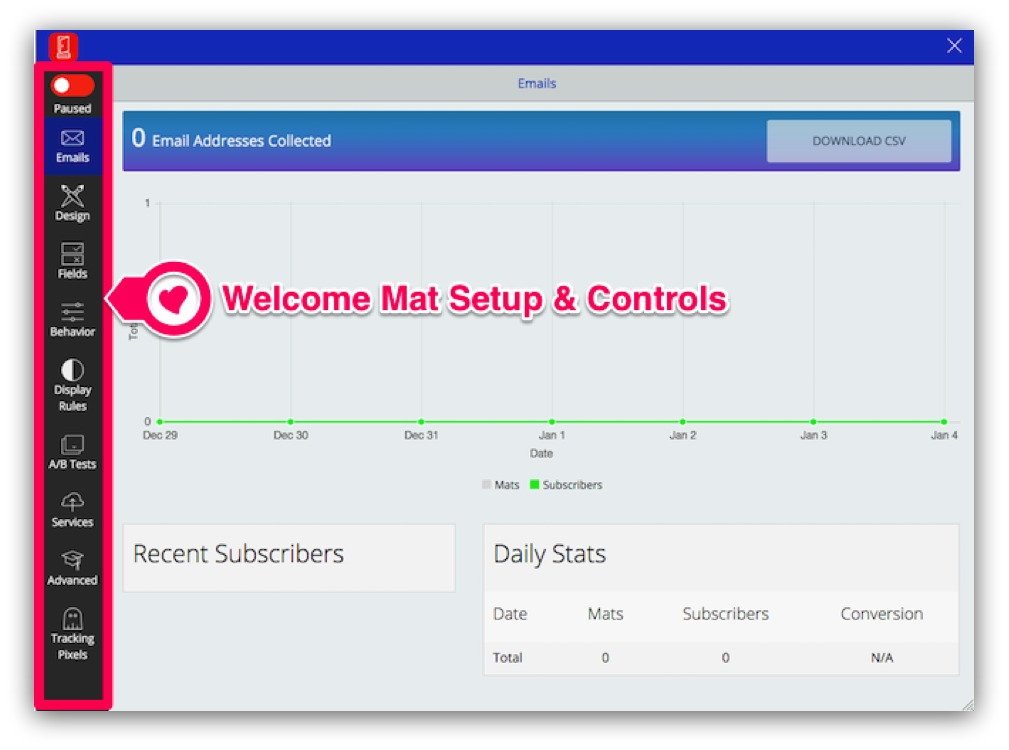
On the left sidebar, you want to click on ‘Display Rules’ which will bring you to this:
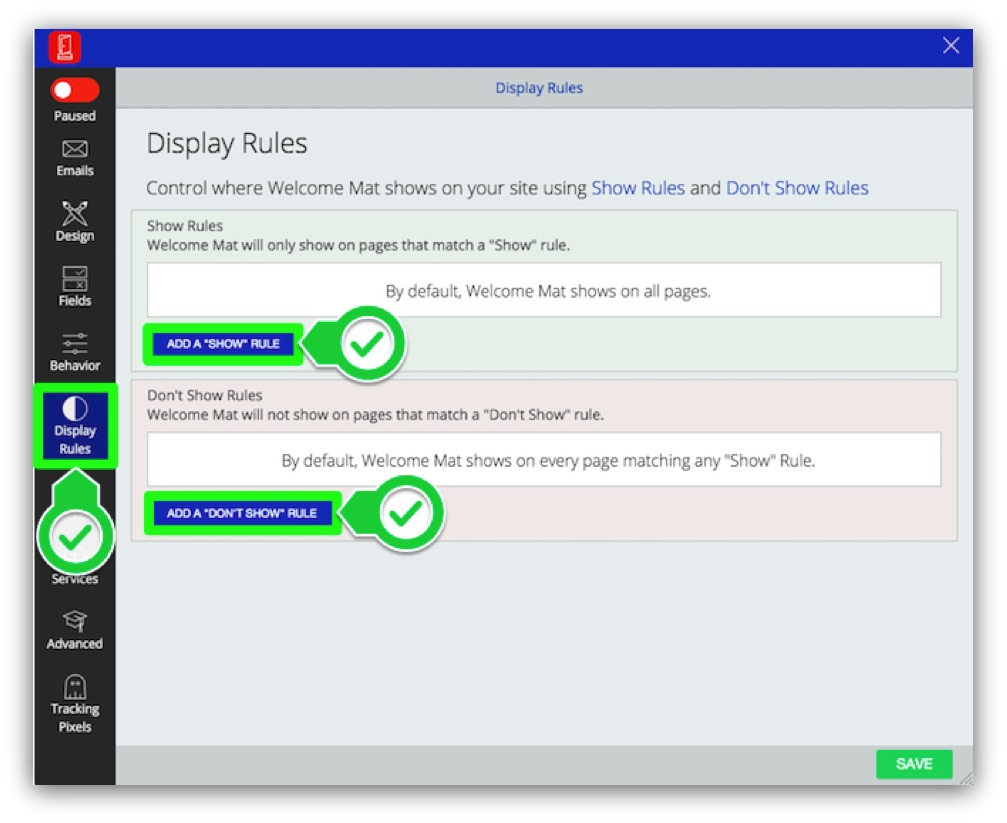
In this section, click on the ‘Add a show rule’ button, so you can control where your Welcome Mat appears on your site.

Click on the ‘On The Home Page’ button and disable ‘instant landing page’ by clicking here:

Just to re-iterate, you’ll want to disable ‘instant landing page’ to really increase your conversions.
And that’s it! In less than few minutes, you can have your own landing page setup to collect emails. If you’re stuck on how to design it, click here for inspiration to get your brain juices flowing.
Those are just two examples of how you could leverage technology. It’s up to you to do the research to find out which technologies you can leverage to automate or scale your marketing channel.
It could be automating your email marketing with an Email Drip campaign, or automating your social media strategy with Buffer. Find out which technologies work for your channel.
But what if you can’t use technology to scale your marketing channel?
Create a Playbook
Remember when I said it was important to document everything you do and to create an experimental plan?
Just like in the science world, your marketing experiments have to be repeatable.

If you documented your process accurately, that’s when you can hire virtual assistants, freelancers, or employees to focus on that one channel.
And that’s it!
Milk that effective marketing channel dry until it’s no longer effective. Once that happens, it’s just a matter of starting the process all over again to find another marketing channel.
Are You Ready To Become A Marketing Scientist?
Stop copy/pasting marketing guides you’ve read about without any sort of framework (including this one!)
Approach each online marketing strategy systematically to generate new marketing tactics based on all the guides you read. You can then test them efficiently, and use the learnings to 10x your results.
Remember, great marketing guides should be used as inspiration, and not as a copy/paste playbook for your business. Each business is different, so it’s up to you to take the learnings from those guides, and customize it to fit your own business.
Start today:
Step 1: Start compiling all the great marketing guides you read into an “ideas backlog” spreadsheet (you can download it at the end)
Step 2: Create and define your goal (based on the AARRR funnel) by working backwards from your end vision. Make sure your goals are specific, measurable, assignable, realistic, and time related.
Step 3: Prioritize your marketing tactics based on how it fits in with the goal, and score them based on the: probability of success, resources required, and impact.
Step 4: Validate the assumptions you used to prioritize the marketing tactics by running small 80/20 marketing experiments. Do this by breaking down your goal into week-to-week growth targets so you can measure your progress.
Step 5: Create an experimental plan by documenting how you will be executing the marketing strategy.
Step 6: Execute your marketing plan and keep detailed notes as you progress through the experiment.
Step 7: Analyze your results by asking “why” the experiment was a success or failure. Do research to find out “why” so you can make tweaks. If the experiment was a failure and it’s too difficult to fix, kill the experiment and move on.
Step 8: If the experiment was a success, apply your lessons learned and scale your experiment in iterative steps. Leverage technology or your playbook to 10x your results. Continue to focus on the marketing channel until it’s no longer effective.
Step 9: Rinse and repeat!
Get The Tools You’ll Need To Create Your Marketing Strategy
One last thing, if you found this post to be valuable, share it to your friends and colleagues by clicking the sharebar to the left of this screen.
If you want a copy of my full Reddit marketing strategy, results, and learnings, ADD A COMMENT. I'll PM you the link to it.
You can also download all the spreadsheets and tools we use so you can do the exact same thing:
Add A Comment
VIEW THE COMMENTS